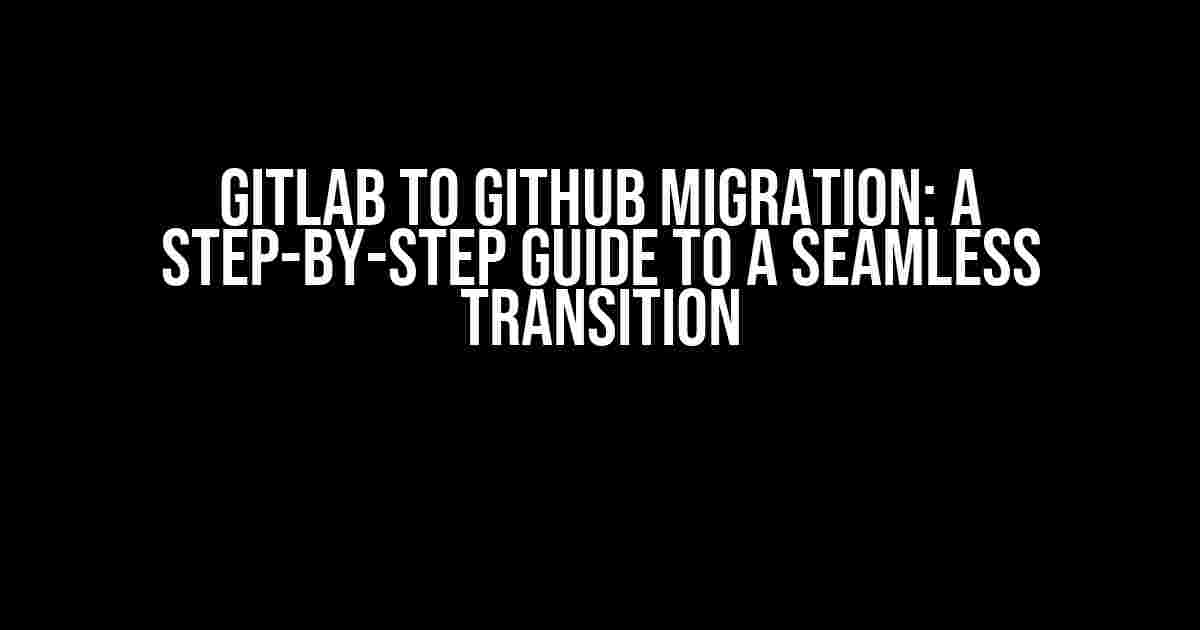Are you tired of using Gitlab and want to switch to Github? Look no further! This comprehensive guide will walk you through the process of migrating from Gitlab to Github, ensuring a smooth and hassle-free transition.
Why Migrate from Gitlab to Github?
Before we dive into the migration process, let’s take a moment to discuss why you might want to make the switch.
Github has become the go-to platform for open-source projects and collaborative development. With a larger community and more features, it’s no wonder many developers are making the switch. Additionally, Github offers a more comprehensive set of tools and integrations, making it an attractive option for teams and organizations.
Pre-Migration Checklist
Before you start the migration process, make sure you’ve completed the following tasks:
- Backup your Gitlab repository: Take a snapshot of your current repository to ensure you don’t lose any data during the migration process.
- Prepare your team: Notify your team members of the upcoming migration and ensure everyone is on board.
- Choose a migration method: Decide on the best approach for your team, whether it’s a manual migration or using a third-party tool.
Method 1: Manual Migration
This method involves creating a new repository on Github and manually pushing your Gitlab repository to the new location.
Step 1: Create a new repository on Github
git init git add . git commit -m "Initial commit"
Step 2: Add the Github repository as a remote
git remote add origin https://github.com/your-username/your-repo-name.git
Step 3: Push your repository to Github
git push -u origin master
Method 2: Using a Third-Party Tool
If you’re not comfortable with manual migration, you can use a third-party tool to simplify the process. One popular option is the gitlab-to-github tool.
Step 1: Install the tool
pip install gitlab-to-github
Step 2: Run the migration command
gitlab-to-github --gitlab-url https://gitlab.com/your-username/your-repo-name.git --github-url https://github.com/your-username/your-repo-name.git
Migrating Wiki Pages and Issues
In addition to migrating your code, you’ll also need to transfer your wiki pages and issues.
Migrating Wiki Pages:
git clone https://gitlab.com/your-username/your-repo-name.wiki.git git remote add origin https://github.com/your-username/your-repo-name.wiki.git git push -u origin master
Migrating Issues:
| Issue | Description | Label | Assignee |
|---|---|---|---|
| Issue 1 | This is issue 1 | bug | @john-doe |
| Issue 2 | This is issue 2 | feature | @jane-doe |
Post-Migration Checklist
After the migration is complete, make sure to:
- Update your repository URL in any integrations orCI/CD pipelines.
- Notify your team members of the new repository location.
- Test your repository to ensure everything is working as expected.
Common Issues and Solutions
During the migration process, you may encounter some common issues. Here are some solutions to get you back on track:
Error: Repository not found
This error typically occurs when the repository URL is incorrect. Double-check the URL and try again.
Error: Authentication failed
This error occurs when your Github credentials are incorrect. Verify your credentials and try again.
Conclusion
Migrating from Gitlab to Github may seem like a daunting task, but with this comprehensive guide, you’ll be up and running in no time. Remember to take your time, follow the steps carefully, and don’t hesitate to reach out if you encounter any issues.
By following this guide, you’ll be able to seamlessly transition from Gitlab to Github, taking advantage of the latter’s features and community. Happy migrating!
- Backup your Gitlab repository
- Prepare your team
- Choose a migration method
- Migrate your repository
- Migrate wiki pages and issues
- Update integrations and notify team members
Remember, migration is a process, and it may take some time to complete. But with patience and persistence, you’ll be enjoying the benefits of Github in no time.
Frequently Asked Questions
Migrating from GitLab to GitHub can be a daunting task, but don’t worry, we’ve got you covered! Here are some frequently asked questions to help you navigate the process:
Why should I migrate from GitLab to GitHub?
Migrating from GitLab to GitHub can provide access to a larger community, more integrations, and a more comprehensive set of features. GitHub is also widely adopted in the industry, making it easier to collaborate with other developers and teams. Additionally, GitHub’s free plan offers more features than GitLab’s free plan, including unlimited private repositories and more storage space.
How do I migrate my repositories from GitLab to GitHub?
You can migrate your repositories from GitLab to GitHub using the GitHub Importer tool or by manually cloning and pushing your repositories to GitHub. The GitHub Importer tool is a faster and more convenient option, as it allows you to import your repository and all its associated data, including issues, pull requests, and comments, in one go.
Will I lose my commit history during the migration?
No, you won’t lose your commit history during the migration. Both the GitHub Importer tool and the manual migration process preserve your commit history, so you can rest assured that your repository’s history will remain intact.
How do I handle differences in GitLab and GitHub workflows?
While GitLab and GitHub share many similarities, there are some differences in their workflows. For example, GitHub uses pull requests, while GitLab uses merge requests. Additionally, GitHub has a more comprehensive set of project management features. You’ll need to adapt your workflow to accommodate these differences, but the benefits of migrating to GitHub will be worth the effort.
Is it possible to migrate my CI/CD pipelines from GitLab to GitHub?
Yes, it is possible to migrate your CI/CD pipelines from GitLab to GitHub. GitHub Actions provides a similar functionality to GitLab CI/CD, and you can recreate your pipelines using GitHub Actions. You may need to modify your pipeline scripts to accommodate the differences between GitLab CI/CD and GitHub Actions, but the process is relatively straightforward.
